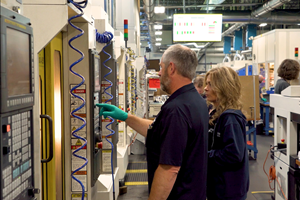OEE May Not Be Enough
Overall equipment efficiency (OEE) is a critical measurement of how well a manufacturing unit is doing. But shops should also focus on profitability, which is where Financial OEE comes in.
Share







Hwacheon Machinery America, Inc.
Featured Content
View More

Overall equipment efficiency (OEE) is considered a critical measurement of how well a manufacturing unit is doing. The formula is simple: It multiplies the percentages of availability, performance and quality to yield a single percentage. This result enables similar units (one machine, one department, one plant or an entire enterprise) to be compared or rated against a target such as a plant’s best record or a benchmark of world-class performance. Focusing on OEE enables manufacturers to pinpoint factors that hold back productivity.
Significantly, recent developments in data-driven manufacturing make calculating OEE easier, faster and more accurate—and acting on it more effective. For example, these benefits are an important advantage of connecting machine tools to a network for data collection and monitoring.
However, shops and plants must also focus on profitability. Managers have to balance decisions about maximizing the part-making capability of their equipment with decisions about the money-making potential of this equipment. OEE ratings alone provide an incomplete picture. One development that seeks to address this shortcoming is called Financial OEE (FOEE), a trademarked name for a new feature of MERLIN Tempus Enterprise Edition (EE) from Memex.
MERLIN (Manufacturing Enterprise Real-time Lean Information Network) is a communications platform for real-time manufacturing analytics. Tempus is the company’s suite of applications for machine monitoring such as real-time views of the plant floor, custom dashboards, reporting, alerting and other functions related to data-driven manufacturing. Tempus EE adds OEE, job scheduling and other modules such as FOEE.
Memex has partnered with noted OEE expert and author Robert Hansen to develop this approach. FOEE answers the question, “What is the value of improving OEE on this particular machine for this particular product?” More to the point, it answers “How much profit is being left on the table by not performing at company-best or industry-best levels for that specific part?” Thus, the FOEE concept shows the power of data-driven manufacturing and the Industrial Internet of Things to transform decision-making not only on the shop floor, but also in the front office.
Tempus EE automatically collects the event details necessary to compute OEE. The first phase of FOEE applies to stand-alone machines making a finished product. FOEE requires three key financial input values for each product and the machine. These inputs are unit sales price, unit material cost and the hourly operational expense (OPEX) of the machine. This information can be derived from the ERP product standard and the income statement.
FOEE is the current-state hourly profit divided by a value representing a world-class level of profit. This ratio tells a company what profit it made compared to what profit could have been made at world-class levels. With this information, a company can see the financial value of improving the machine’s performance.
In the figure on page 40, a product called P0006 is analyzed over 180 days. The product-run OEE data is correlated with the three inputs necessary for FOEE. It also associates important actionable data such as profit contribution per hour and current FOEE based on the machine’s best FOEE percentage, as well as how much more profit would accrue by running the machine at its best OEE rate.
With FOEE, managers can look at jobs scheduled for a machine and make decisions based not just on utilization, but also on utilization and profit. This enables managers to compare a list of machines capable of running a certain job, and to determine which machine would yield the highest hourly profit. Just as the OEE figure related to each project or job is a key tool in prioritizing and evaluating continuous improvement projects, FOEE provides a quick view of the profitability opportunity for these projects. FOEE is a tool to make better business decisions for scheduling products, guiding continuous improvement efforts and giving important feedback to sales and marketing teams.
Related Content
Shop Quotes Smarter, Works Harder with Machine Monitoring
Temco first installed MT-LINKi to optimize quoting. Now, the software helps the shop optimize its machines — and machine purchases.
Read MoreCan Connecting ERP to Machine Tool Monitoring Address the Workforce Challenge?
It can if RFID tags are added. Here is how this startup sees a local Internet of Things aiding CNC machine shops.
Read MoreSwiss-Type Control Uses CNC Data to Improve Efficiency
Advanced controls for Swiss-type CNC lathes uses machine data to prevent tool collisions, saving setup time and scrap costs.
Read MoreEasy-To-Install Data Acquisition System for Real-Time Monitoring Across Brands
cnSEE from All World Machinery Supply combines easy installation and monitoring across multiple machines.
Read MoreRead Next
Registration Now Open for the Precision Machining Technology Show (PMTS) 2025
The precision machining industry’s premier event returns to Cleveland, OH, April 1-3.
Read MoreBuilding Out a Foundation for Student Machinists
Autodesk and Haas have teamed up to produce an introductory course for students that covers the basics of CAD, CAM and CNC while providing them with a portfolio part.
Read More5 Rules of Thumb for Buying CNC Machine Tools
Use these tips to carefully plan your machine tool purchases and to avoid regretting your decision later.
Read More












































